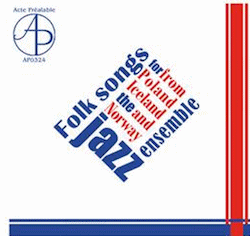Gódi Jesú, lifsins ljómi (Iceland) [5:47]
Ó, ó, hver vill mig verja (Iceland) [3:56]
Gud oss sinn laerdóm ljósan gaf (Iceland) [4:53]
Ułani (Poland) [6:06]
Kazali mi śpiewać (Poland) [7:35]
Pragną oczka (Poland) [6:12]
Baadnlaatt (Norway) [4:34]
Hjuring - jenta (Norway) [5:07]
Ewa Murawska (flute)
Áshildur Haraldsdóttir (flute)
Lars Asbjórnsen (flute)
Katarzyna Stroińska-Sierant (piano)
Maciej Kociński (saxophone)
Jan Adamczewski (saxophone)
Piotr Max Wiśniewski (double bass)
Sławomir Tokłowicz (percussion)
Mirosław Kamiński (percussion)
Recorded 2013 Studio Free Fly Music and Studio Spendor i Słlawa
ACTE PRÉALABLE AP0324
[44:13]
The bottom line here is that this is an album that seeks to ‘find a common denominator between the improvisatory factor of folk music and jazz
improvisation’ and focuses on the traditional music of Iceland, Norway and Poland. Phew. What can this mean? Support comes from The European Folk Forum,
though this august body may be surprised to learn that only four of the eight tracks feature the flute. Various academic institutions in the three
countries are partners.
The fear is that the resultant album will be a pottage of academic didacticism, like those ridiculous poetry-and-jazz vamps that stoned students in the 60s
lapped up. It’s not like that, but I did wonder how the process of taking native themes and parcelling them out to an ensemble of piano, flute, saxes, bass
and percussion was going to advance the project and reconcile such disparate music. In the end I decided to hang my hat and listen to the music.
There are eight tunes, and Norway only gets two, Iceland and Poland having three each. One hears nice rolling piano, laid-back tenor solo a bouncing theme
in the first track whereas the second is more explicitly revealing of its folkloric roots – and pianist Katarzyna Stroińska-Sierant has obviously listened
to Keith Jarrett; the music moves uneasily between Blue Note and folky-filmic. The final Icelandic tune is pretty, with a cimbalom-like sound and plenty of
romantic reserve with the flute’s warm lines lulling and beguiling. The Polish trio of pieces include an airy piece, a kind of ballad and an interesting
finale. The most intriguing, perhaps ungainly offering is the first Norwegian one in which the vibe is Kinky Boots meets King Curtis. Try smoking that. The
album’s last piece is very lyrical with a wordless vocal from the pianist.
What can one say about this? At 44-minutes it doesn’t outstay its welcome. I think it’s more a cultural aspiration than a musical success. Can folk songs
be played by a jazz ensemble without subtracting from them or accreting to them a spurious ethos? Probably not, but I think it would have needed an
infusion of John Surman’s kind of jazz hinterland to draw deeper into the concept.
Jonathan Woolf
